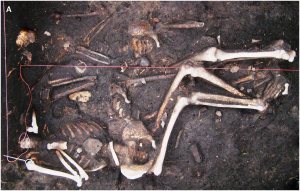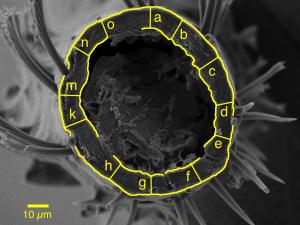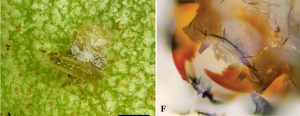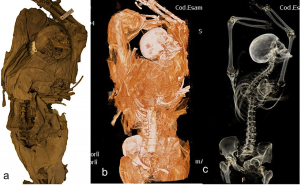PLOS ONE’s Spookiest Papers of 2016
This Halloween season we take a look back at some of the spookiest images and creepiest findings that we published in PLOS ONE in 2016. Creepy, weird, skin-crawling, or just plain gross – we hope you enjoy these spooky studies as much as we do!
Have your own favorite creepy PLOS ONE research? Let us know in the comments!
Plague and pestilence.
PLOS ONE started the year off with a spooky bang with a study looking at ancient plague victims from two burial sites in Germany. The researchers recovered ancient DNA from the skeletal remains of victims who succumbed to the pandemic plague from the 14th to 17th century, and found evidence of long-term persistence of Yersinia pestis in an unknown European reservoir.
Lingering clues of predator and prey.
Nothing creeps some of us out faster than the sight of a big spider when we weren’t expecting it. But as a recent PLOS ONE study shows, evidence of both spider and prey may linger even after both are long gone. Using genetic sampling from black widow spider webs, researchers were able to detect the DNA of both spider and prey up to 88 days later! Essence of spider? Sounds appropriate for Halloween….
Roosting bats.

Bats are typical Halloween creatures but can cause problems when it comes to their destructive bat droppings. As many Natterer bats take up dwellings in medieval churches across England, there is a need to find a way to move them away from culturally important parts of the church, while supporting conservation efforts for these animals. In a PLOS ONE study published this year, researchers found that emitting high frequency ultrasound forced bats to find alternative roosts and creating “no-fly” zones with artificial lights helped protect precious areas.
Creepy crawlies that go bite in the night.
This image may not seem too freaky……that is, until you learn its an up close and personal view of a bed bug! It’s enough to make your skin crawl and itch just thinking about the nighttime bed bug which feasts upon us as we sleep. Luckily insecticides exist for those unfortunate infestations but, more recently, these blood-thirsty insects have literally been developing a thicker skin (cuticle) to resist these insecticides as one PLOS ONE study found out.
Things that lurk in the deep.
What can be creepier than things that lurk out of sight in the dark and the deep? These two new species of Barreleye fish confirm our worst nightmares about what might be living below when we’re in the ocean. Luckily, these deep sea fish live far enough below the surface that we’re not likely to ever bump into one out for a swim.
I’ll bite your head off and eat you.
If that doesn’t give you the frights, how about a creepy new species of parasitoid wasp that feasts upon immature psyllid insects inside galls (rounded outgrowths) of the Garuga pinnata tree in India? To prepare its prey for eating, the wasp larva first coils its long body around the psyllid before killing it by biting its head off. After its insect appetizer the larva munches away at the plant tissue and it is this “omnivorous” diet that makes this wasp different from other parasitoid wasps.
Cannibal spiders.
Still not sufficiently creeped out? How about these images of a female colonial orb-weaving spider mating with, then devouring (!) a male? A PLOS ONE study published in June showed that the males of this species were choosier than females when selecting their mates, opting for younger well-fed females. But if you knew it was going to be your last act, wouldn’t you be choosy too? Either way, we can add “cannibal” to the list of creepy spider attributes.
Bringing the dead back to life.
Rounding out our list, what could be more spooky than a pile of 60 natural mummified bodies from the 16th to 18th Century? This gruesome pile was found during a church restoration in Italy in 2009. To bring the mummies “back to life” a recent study used CT scanners to discover the mummies’ pasts. They found that the mummies died for a variety of reasons from degenerative diseases to cancer.
That finishes our Tour de Terror, hope we didn’t scare you too much! Happy Halloween from PLOS ONE!
Images and Citations:
Plague victims: Seifert L, Wiechmann I, Harbeck M, Thomas A, Grupe G, Projahn M, et al. (2016) Genotyping Yersinia pestis in Historical Plague: Evidence for Long-Term Persistence of Y. pestis in Europe from the 14th to the 17th Century. PLoS ONE 11(1): e0145194. doi:10.1371/journal.pone.0145194
Spider DNA: Xu CCY, Yen IJ, Bowman D, Turner CR (2015) Spider Web DNA: A New Spin on Noninvasive Genetics of Predator and Prey. PLoS ONE 10(11): e0142503. doi:10.1371/journal.pone.0142503
Bats: Zeale MRK, Bennitt E, Newson SE, Packman C, Browne WJ, Harris S, et al. (2016) Mitigating the Impact of Bats in Historic Churches: The Response of Natterer’s Bats Myotis nattereri to Artificial Roosts and Deterrence. PLoS ONE 11(1): e0146782. doi:10.1371/journal.pone.0146782
Bat Images:
- By Guido Gerding – Personal photograph taken by Author, URL: Ex :: Natura – Freies Portal für Umweltbildung (Environmental Education), CC BY-SA 3.0, https://commons.wikimedia.org/w/index.php?curid=46563681
- By John Salmon, CC BY-SA 2.0, https://commons.wikimedia.org/w/index.php?curid=9176981
Bed Bugs: Lilly DG, Latham SL, Webb CE, Doggett SL (2016) Cuticle Thickening in a Pyrethroid-Resistant Strain of the Common Bed Bug, Cimex lectularius L. (Hemiptera: Cimicidae). PLoS ONE 11(4): e0153302. doi:10.1371/journal.pone.0153302
Barreleye fish: Poulsen JY, Sado T, Hahn C, Byrkjedal I, Moku M, Miya M (2016) Preservation Obscures Pelagic Deep-Sea Fish Diversity: Doubling the Number of Sole-Bearing Opisthoproctids and Resurrection of the Genus Monacoa (Opisthoproctidae, Argentiniformes). PLoS ONE 11(8): e0159762. doi:10.1371/journal.pone.0159762
Parasitoid Wasp: Ranjith AP, Quicke DLJ, Saleem UKA, Butcher BA, Zaldívar-Riverón A, Nasser M (2016) Entomophytophagy (‘Sequential Predatory, then Phytophagous Behaviour’) in an Indian Braconid ‘Parasitoid’ Wasp (Hymenoptera): Specialized Larval Morphology, Biology and Description of a New Species. PLoS ONE 11(6): e0156997. doi:10.1371/journal.pone.0156997
Cannibal spider: Yip EC, Berner-Aharon N, Smith DR, Lubin Y (2016) Coy Males and Seductive Females in the Sexually Cannibalistic Colonial Spider, Cyrtophora citricola. PLoS ONE 11(6): e0155433. doi:10.1371/journal.pone.0155433
Mummies: Petrella E, Piciucchi S, Feletti F, Barone D, Piraccini A, Minghetti C, et al. (2016) CT Scan of Thirteen Natural Mummies Dating Back to the XVI-XVIII Centuries: An Emerging Tool to Investigate Living Conditions and Diseases in History. PLoS ONE 11(6): e0154349. doi:10.1371/journal.pone.0154349







